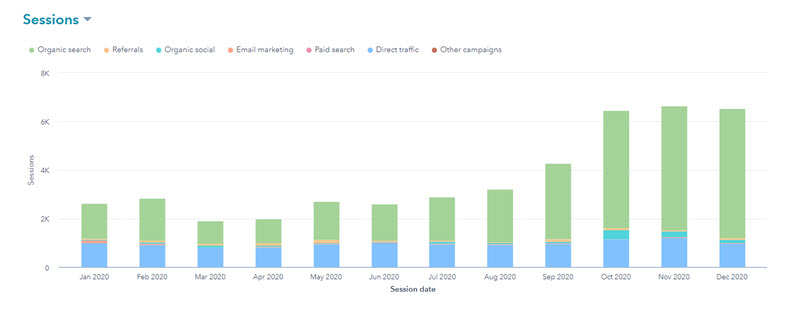What Is Inbound Marketing?
Consumers and business purchasing agents have never been more empowered than they are today. The ability to resist marketing messages from companies...

One of the biggest myths among small business owners is that having an attractive company web design is going to generate leads. This couldn’t be further from the truth. While having an up-to-date website is certainly a business necessity in today's market, just having a functioning website does not qualify as a lead generation technique.
Lead generation is an active ongoing process that seeks to attract and convert targeted web visitors into qualified prospects. Lead generation as a process requires multiple tools, marketing services and an investment of time and money. The ultimate goal is to increase sales.
Building a company website is just the beginning of online lead generation. What happens after your website is launched matters most. In this article we will look at several online lead generation techniques that should be considered as part of your lead generation strategy.
There are numerous lead generation techniques that can be used to generate the right leads to meet your business goals. However, these top lead generation techniques are used by the majority of people who know how to use them effectively.
Organic search is a process of entering one or more search terms into a search engine. Organic search results are the listings on a Search Engine Results Page (SERP) that appear because of their relevance to the search terms that were input into the search engine. These do not include the advertisements appear at the top and bottom of the results page.
Why is organic search important? Because, Google gets over 100 billion searches a month worldwide. (Source: Mashable)
Search Engine Optimization (SEO) is crucial for your website so that it is ranked higher on the SERP for keywords that are related to you business. When done correctly, this will allow your potential customers to discover your business when searching for the products or solutions you provide.

One of the exciting benefits of SEO, when it is executed properly as a lead generation technique, is that it can bring more targeted and qualified leads to your company website.
71% of B2B researchers (buyers) start their research with a generic search. (Source: Google)
This is good news for small businesses. SEO keyword research allows businesses to target keywords and phrases that potential customers are using to search for solutions to their problems.
The challenge is applying those keywords to your website and internet marketing strategy so that they actually bring you customers. Here are some SEO strategies to consider:
Most company websites are designed to be informative and not to generate leads. Does your website tell them how good you are ? And, is it designed to showcase your company like a bright shiny brochure? If so, then you are too focused on yourself and not on your customers. You are too “me centric” or “company-centric.”
When visitors go to a website, they are looking for something. They want to know if you have what they are looking for or if you can help them solve their problem.
When they get to your website, if they do not see what they are looking for, understand what you do or determine whether you can solve their problem, they will go elsewhere.
Contrast this with a lead generation website that is designed to make it easy for clients to understand what your value proposition is, download valuable information or request a proposal. This type of website incorporates tools like content offers, landing pages, calls to action, lead flows and forms. With these tools in place, you will create a website that is set up to generate targeted leads out of visitors who are interested in what you have to offer.
You can learn more in our eBook, The Top 5 Things Your Website Needs To Make Money.
Business blogging, when done consistently is a key source of traffic generation for your website. With each new entry on your blog, you provide an opportunity for your prospects to find you, find a solution to a problem and subsequently learn about the solutions that your company provides.
Here is why it works: Every time you create and publish a new blog post, a new URL is created and added to your website. Search engines such as Google, Bing and Yahoo periodically crawl your website looking for new information and updates. When new pages are found, these search engines organize this new information by indexing it in their database.

Once your new page is added to a search engine index, it has the opportunity to be found when a person enters a search query. With each successive blog entry, you have a new way to be found online. What’s even better, blogging allows you to attract “good traffic.” By writing about topics that your ideal customers are searching for, you have a greater chance of attracting the type of qualified visitors that will be candidates for your product offerings. Do you think blogging is too much work for the return?
Consider these recent stats:
As these statistics illustrate, blogging is no longer just an option for online lead generation. It is quickly becoming a necessity.
More people begin their buying journey by researching online before ever reaching out to a solution provider. By utilizing your blog, you can help influence customer behavior and favorably increase the odds of influencing visitors to your website with well-researched articles.
Through the use of content marketing, leads can be obtained a lot easier if your business is seen as a trusted resource of knowledge in its area of specialization. eBooks are a way for you to demonstrate expertise and thought leadership. They make it easy for the potential customer to learn more about your company, your products or services, and also about the area of business you operate in
Pick subjects that are relevant to the information your target customers are looking for. In other words, provide information regarding their common challenges or needs. This is one of the most common techniques for lead generation because it establishes credibility and attracts qualified leads. You can offer them an eBook on your website for free if they fill out a form. Once they fill in the form, you now have information with which to continue nurturing them.
An important point to remember here is that you don't want to ask for so much information that it becomes too much trouble for them to get the eBook. If they feel like you are asking too much, they won't download it. This is particularly true when it comes to their phone number. Most people are willing to give an email address, but won't give a phone number and risk getting calls.
So, make it easy for them to get information from you.
5. Creating Lead Generation Videos
 Video is everywhere today, and for good reason. It is an ideal marketing medium for businesses to attract visitors and prospects. You can use videos to explain how to use a product, solve a problem, explain a concept or tell a story of how you helped a customer solve a problem.
Video is everywhere today, and for good reason. It is an ideal marketing medium for businesses to attract visitors and prospects. You can use videos to explain how to use a product, solve a problem, explain a concept or tell a story of how you helped a customer solve a problem.
And, if you can be funny or entertaining in the process, that is even better.
Check out these statistics:
Video can play an important role in attracting traffic to your website, generating leads and nurturing leads
Email marketing is dead. Have you heard this before? Not so! The statistics don't bear it out.
Email marketing offers an overwhelming return on investment. Just look at this statistic:
According to the Direct Marketing Association, email marketing yields an estimated 4,300 percent ROI. That means for every $1 invested, it returns $44. (Source: Entrepreneur)
Many businesses have the misperception that email marketing is only used to communicate with existing customers. However, email can be a great way to develop and nurture new leads.
Here are a few best practices to drive new business:
Speaking of social media...
Facebook, Twitter, Instagram, YouTube, Google Places and LinkedIn are on most business owner’s radar screen. However, most small businesses are doing a poor job of capitalizing on the massive numbers of people that flock to these sites on a daily basis.
Here is a sobering statistic:
41% of US small businesses surveyed in Spring 2015 said they didn’t use social media for business. This was up slightly from 38% in Fall 2014 and even with the 41% in Spring 2014. (Source: eMarketer)
 For those that are participating in one way or another, many are missing the mark. Incomplete profiles, inconsistent posting and tone-deaf voices are among the many mistakes that small business owners are making with their social media.
For those that are participating in one way or another, many are missing the mark. Incomplete profiles, inconsistent posting and tone-deaf voices are among the many mistakes that small business owners are making with their social media.
While social media marketing can be a time-consuming lead generation technique, it can also help you connect on a deeper level with potential customers. Think of Facebook, Twitter, Instagram, YouTube, Google Places and LinkedIn as different virtual phone books that can actively be searched for your services using keywords. So, it allows you to engage with people who are great prospects for your products or services.
Social media is growing fast and requires more sophistication and attention to be a successful lead generation tactic. Here are a few best practices to consider:
Using Calls to Action (CTAs) to drive conversions is paramount. Think of it this way...Let's say your car or phone navigation system said to you after you put in your desired route, "In 1-mile turn," and then said nothing else. How would you know where to go?
That's pretty much what it is like having no CTAs on your website. CTAs are designed to take your website visitors to a specific place on your site and complete an action. Your CTA's should be managed in 3 distinct stages:
The "sales funnel" is the theoretical model for the process a buyer will go through before making a purchase. It is also known as the "buyers journey". Understanding each of these sections will help you determine which CTAs to place on your website.
The top of the funnel CTAs are designed to keep your web visitor on your website and provide easy access to further knowledge about what they are searching for. CTAs like Learn More, Read More, Quick View, and Download can be utilized to direct visitors to educate themselves further. This is especially important if your product or service requires more education before a purchase is typically made.
Middle of the funnel CTAs are used to move your visitor from a "just-looking" phase toward a "this is interesting and I want to learn more" phase. At this stage, they move into a new buying position where they will start to consider your product or service as a possible purchase. This is where you can now provide additional information that helps them move from "considering or evaluating" into a "possible purchase" with you. These CTAs might include Get Your Free eBook, Watch the Demo Video, or Free Webinar Sign Up.
This stage is where you try to close the sale. You will typically use CTAs like Request A Free Quote, Free Trial, Free Estimate" or Add To Cart & Save 25%, Free Product Demo. It's important to remember that if you don't ask for the sale, you may not get it!
It's important to place your CTAs in places that are appropriate. The core concept for the creation and placement of CTAs is Value and Relevance. If you have a blog article designed to provide awareness of your product or service, you would not use a bottom-of-the-funnel CTA like Get A Free Trial in the article. A middle-of-the-funnel CTA would be a better option here since the buyer is just likely becoming aware of your product or service.
Think through the process of how someone will purchase your product or service and place the CTAs that provide the most value and relevance to that specific page.
You can tap into new audiences by accepting guest posts on your own website. There are a couple of approaches you can take when doing this:
Both guest post options will require some investment of time and money on your part to accomplish your goals.
Help Is Near
The techniques above are some of the most important tactics available to business owners today. The inbound marketing process uses all these tactics.
But you may be wondering, Is inbound marketing right for my business?
In a perfect world, you would use all of these lead generation techniques as a part of your internet marketing strategy. For many business owners, the thought of delving into this online territory will be as appealing as having a root canal performed. However, there is help. A great online marketing firm can be a life saver.
You can learn more in our article, Why Should I Hire a Marketing Agency For My Small Business?
These techniques can be accomplished by motivated individual business owners or a small staff, but will most certainly require both time and money to be effective. With that in mind, we created a free business resource to help you create more effective leads for your sales team. Download a copy of “The 30 Greatest Tips, Tricks and Ideas” today to learn more about these strategies and many more available to you. Either way, as the statistics in this article show, you need a strong digital strategy to remain competitive now and in the future.

Consumers and business purchasing agents have never been more empowered than they are today. The ability to resist marketing messages from companies...

If you have done any research lately about using the internet to develop leads for your business, you may have heard about inbound marketing. ...

My business partners and I were on a sales call recently with a business owner that is in desperate need of expanding her business. She has all her...